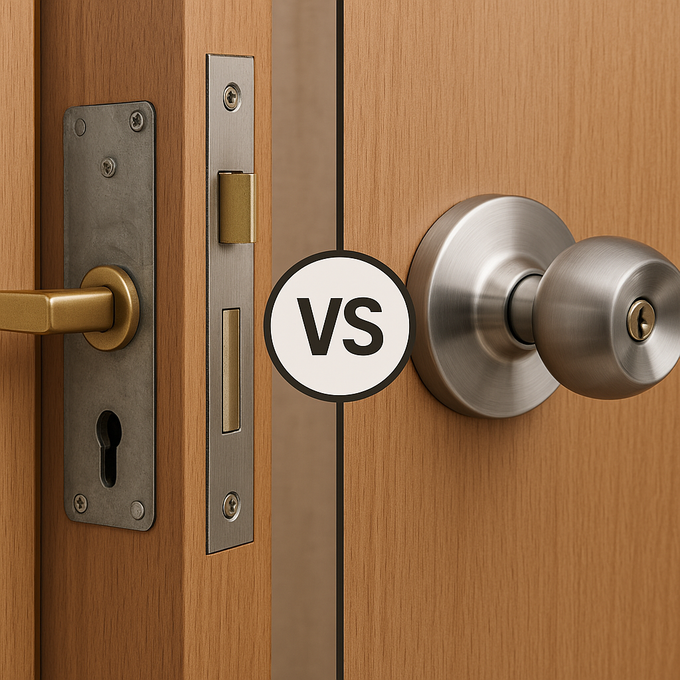
Mortise Lock vs Cylindrical Lock: Which One Should You Buy?
Posted by National Lock Supply on Oct 9th 2025
If you’re a homeowner or you manage a small office and you’re serious about security, you’ve probably run into the age-old choice: mortise lock or cylindrical (bored) lock. On paper, they do the same job, keep bad actors out and let the right people in. In the real world, the differences in durability, security, installation, and cost are big enough that choosing the right one can save you money, headaches, and maybe a door frame.
I’ll walk you through how each lock works, where each shines, and how to make a confident decision. I’ll keep it straightforward and practical, exactly how I explain it to clients who’ve been taking care of houses and offices for decades and want to upgrade without drama.
How These Locks Actually Work
Mortise Locks—A self-contained steel box that does it all
A mortise lock is a heavy, rectangular lock case that slides into a pocket (the mortise) cut into the door’s edge. Inside that case are thick steel parts, a latch, sometimes a separate deadbolt, levers, cams, and springs—designed for high cycle counts and rebuildability. Your exterior trim (knob or lever and the escutcheon/plate) attaches with through-bolts that tie both sides together through the steel case, which reinforces the door.
- Cylinder type: Mortise locks use a mortise cylinder (threaded, with a tailpiece cam). You can swap this cylinder for higher-security options without replacing the whole lock.
- Strike hardware: Typically a box strike or armored strike goes into the frame, giving the latch/bolt more metal to bite into.
- Functions: Entry, office, storeroom, privacy, classroom, etc. Commercial and premium residential hardware cover the full function set.
Bottom line: A mortise lock is the “all-in-one, beefy gearbox” of door locks. It’s built to be serviced and to survive serious use.
Cylindrical Locks—Faster to install, the everyday workhorse
A cylindrical lock sits in a 2-1/8" cross-bore hole with a 1" edge bore for the latch. The latch and retracting mechanism live in a compact chassis. If you’ve replaced a knob or lever yourself, you’ve probably dealt with this format.
- Cylinder type: Typically a key-in-knob/lever cylinder or a small/large format interchangeable core (IC) in commercial settings.
- Strike hardware: Standard strike plate is common; you can upgrade to reinforced strikes for better kick resistance.
- Deadbolts: On residential doors, the deadbolt is often separate, adding a second bore above the knob/lever.
Bottom line: Cylindrical locks are simpler and cheaper to install and replace. With the right grade and strike reinforcement, they’re perfectly adequate for many homes and light-to-medium duty offices.
Quick Comparison: Durability, Installation, Security, Price
Durability
- Mortise: Thick steel components; handles daily abuse; easily serviceable; often chosen for high-traffic doors.
- Cylindrical: Durability ranges widely by ANSI/BHMA grade. Grade 1 commercial cylinders are robust; Grade 2 and 3 are lighter-duty.
Takeaway: If the door sees hundreds of uses per day—or you want a lock that can be rebuilt instead of replaced—mortise wins.
Installation
- Mortise: Requires cutting a pocket in the door with a mortising jig. Best done by a pro, especially on finished doors.
- Cylindrical: Drill, bore, done. Very DIY-friendly. Great for quick retrofits.
Takeaway: If you’re replacing an existing cylindrical lock with minimal fuss, stay cylindrical. If you’re doing a significant security upgrade or a new build, mortise is attainable and worth it.
Security
- Mortise: Strong chassis, through-bolted trim, thicker latch/bolt options, box strikes, and easy cylinder upgrades (e.g., restricted keyways, high-security cylinders). Excellent pry and torque resistance when installed with the right strike and screws.
- Cylindrical: Security varies by grade and cylinder. With reinforced strikes, long screws, and a separate Grade 1 deadbolt, you can get strong residential protection. Many commercial cylindrical sets accept high-security cores as well.
Takeaway: Mortise offers higher baseline security and upgrade paths. A cylindrical can be secured well with smart upgrades and a good deadbolt.
Price
- Mortise hardware: ~$250–$800+ per door for quality sets (trim, case, cylinder not including high-security cylinder upgrades). Pro install for new mortising typically adds $150–$300 per door.
- Cylindrical hardware: ~$40–$150 for residential Grade 2/3; $150–$350 for Grade 1 commercial. Pro install of a direct replacement typically $80–$150; add labor if drilling a new deadbolt or reinforcing the frame.
Takeaway: Cylindrical is budget-friendly and fast. Mortise is an investment that pays off in longevity and security—especially for primary entry doors and busy offices.
Real-World Scenarios: What Makes Sense Where
When a Mortise Lock Makes Sense
- Primary Front Door on a Stand-Alone Home
You want a strong, secure feel at the door you use the most. Mortise gives you a solid latch engagement, an optional integrated deadbolt, and excellent pry resistance when paired with a reinforced or box strike. If you’re upgrading an older door during a remodel, it’s a smart time to mortise. - Busy Home Office or Small Business Entry
If employees or clients are in and out all day, the duty cycle matters. Mortise locks are designed for hundreds of operations daily. You can also adopt restricted keyways to control copies and simplify master keying. - Historic or Premium Aesthetic
Mortise escutcheons and trims are available in traditional and high-end designs that fit older homes better than most cylindrical sets. You get both looks and longevity. - Steel or Solid-Core Doors with Heavy Closers
Doors that close hard stress cheap locks. Mortise hardware stands up to door closers and heavy doors far better over time.
When a Cylindrical Lock Is Enough
- Budget-Conscious Upgrades on Rentals or Secondary Doors
For side doors, mudroom doors, interior office doors, or rental turnovers, a Grade 2 cylindrical knob/lever with a separate Grade 1 deadbolt and reinforced strike is a cost-effective package. - Fast Retrofits for Existing Bored Doors
If your door already has a 2-1/8" bore, staying cylindrical avoids patching or re-mortising. Add a security strike and 3" frame screws, and you’ve significantly improved resistance to forced entry. - Light-to-Medium Traffic Commercial Doors
A Grade 1 cylindrical lever with an IC core can be a great fit where you need clean rekeying (swap cores, move on) but don’t have extreme abuse or security requirements.
A Closer Look at Security
Security is a system. Both lock types benefit, or suffer, based on the door, frame, and hardware around them.
- Strike reinforcement: Upgrading to a box strike or heavy-duty security strike with 3" screws into the wall stud is one of the biggest bang-for-buck improvements.
- Door material: Solid wood, laminated, or steel doors hold hardware better. Hollow-core exterior doors are a non-starter.
- Hinge side: Use long screws on hinge plates and consider hinge security pins on out-swing doors.
- Cylinder quality: Both mortise and cylindrical locks can accept restricted keyways and high-security cylinders (drill/pick resistant with patented keys).
- Deadbolt throw: A 1" throw on deadbolts with a matching reinforced strike is essential if you’re using a separate deadbolt.
Why mortise starts ahead: The steel case, through-bolted trim, and box strike create a more rigid system out of the box. You can achieve similar rigidity with a cylindrical by adding a separate Grade 1 deadbolt and reinforced strikes—but it’s typically two pieces of hardware, not one integrated unit.
Installation Notes for the “I’ve Got Tools” Crowd
- Backset and door prep: Cylindrical locks typically use 2-3/8" or 2-3/4" backset. Mortise prep dimensions vary by manufacturer—follow the template exactly.
- Door thickness: Most mortise sets expect 1-3/4" doors, though there are 1-3/8" solutions. Most cylindrical sets cover 1-3/8" to 1-3/4" out of the box with adjustable latches.
- Through-bolting: If your cylindrical lock offers through-bolts, use them. They reduce flex and improve longevity.
- Lever vs knob: For many men in their 50s, levers are easier on the hands and comply with ADA in commercial applications.
FAQs: Straight Answers
What’s the cost difference?
Expect mortise hardware in the $250–$800+ range per opening, plus $150–$300 for professional mortising if your door isn’t prepped. Cylindrical sets run $40–$150 for residential Grade 2/3, $150–$350 for Grade 1 commercial. Pro replacement runs $80–$150 for a direct swap, with additional labor if drilling a new deadbolt or reinforcing the frame.
Which is more secure?
Mortise provides a stronger baseline due to the steel case, through-bolting, and typical strike options. That said, a Grade 1 cylindrical lock plus a Grade 1 deadbolt, both with reinforced strikes, is excellent for most homes.
Are they compatible with my existing doors?
If your door is already bored for cylindrical hardware, sticking with cylindrical is the quickest route. Mortise requires a pocket cut into the door and works best on 1-3/4" thick doors (though 1-3/8" is possible with the right hardware). If you’re remodeling or replacing the slab, mortise is very doable.
What about rekeying and key control?
Both formats can be rekeyed. Mortise cylinders and many cylindrical locks accept restricted or high-security cylinders to control duplicates and resist picking/drilling. In offices, IC cores (in either format) let you change keys fast—swap the core and you’re done.
Do I need a separate deadbolt with a mortise lock?
Many mortise entry sets integrate a deadbolt into the same case. That’s part of their appeal—one robust mechanism, one keyhole, very rigid.
Will a mortise lock look out of place on my house?
Not at all. Mortise trims come in modern, transitional, and classic designs. If anything, the finish and plate options are broader at the premium end.
I’m worried about kick-ins. What should I prioritize?
Reinforce the strike side first: box/security strike, 3" screws into the stud, and a solid door. Then pick the best lock you can afford, mortise if possible, or Grade 1 cylindrical + Grade 1 deadbolt. Don’t forget hinge-side long screws or security studs.
Final Recommendation
If you’re weighing this decision for a primary home entry or a busy office, our professional take is simple:
- If your budget and door construction allow it, go mortise. You’ll get a higher baseline of security, better long-term durability, and clean upgrade paths (restricted keys, high-security cylinders, electrified functions). It’s a buy-once-cry-once move that pays off every time you shut the door.
If you need a fast, cost-effective improvement, especially on doors already bored—choose a Grade 1 cylindrical lock and pair it with a Grade 1 deadbolt, reinforced strikes, and 3" screws. That combo is more than “good enough” for most homes and many offices.
 SAME DAY & EXPEDITED SHIPPING AVAILABLE
SAME DAY & EXPEDITED SHIPPING AVAILABLE





